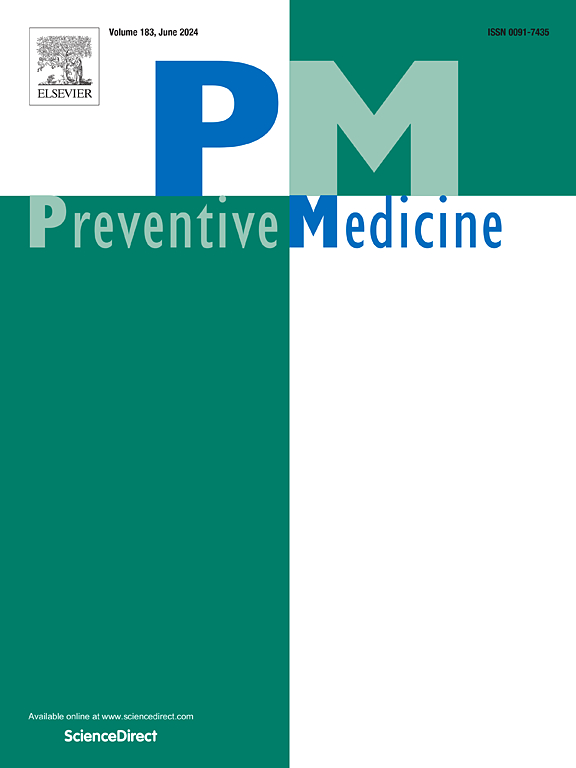Physical activity in youth and cardiovascular disease risk in later-life: Mediation by mid-life factors in a large cohort of Swedish adults
IF 3.2
2区 医学
Q1 MEDICINE, GENERAL & INTERNAL
引用次数: 0
Abstract
Objective
The aims were to investigate the association between youth physical activity and the risk of cardiovascular disease (CVD) later in life in men and women and whether mid-life lifestyle-associated factors, including exercise, smoking, Body Mass Index (BMI), and cardiorespiratory fitness (VO2max), mediate this association.
Methods
Data from 269,431 Swedish participants (52 % men) who participated in occupational health profile assessments between 1995 and 2023 were included. Youth physical activity was self-reported as overall participation in school-based physical education and physical activity outside school before age 20. CVD incidence was obtained from national registers. Mediation analyses assessed mid-life lifestyle-associated factors' influence on the association.
Results
Compared to those reporting no physical education participation, participation in only physical education was associated with a 18 % lower risk for CVD later in life (HR = 0.82, 95 % CI 0.70,0.95). Participating in additional physical activity outside school yielded varying risk estimates (HR = 0.78, 95 % CI 0.67,0.90 for one to two times/week; HR = 0.84, 95 % CI 0.73,0.97 for three to five times/week). VO2max, BMI, and smoking mediated 16 %–32 % of the association. In the single mediation model, cardiorespiratory fitness explicitly mediated the association in those who participated in physical education and at least one weekly sessions of physical activity outside school.
Conclusion
Youth refraining from participating in physical education class could be considered a risk group for later-life CVD. Mediation analyses suggest that engaging in only physical education or with additional physical activity outside school in youth, may confer more healthy behaviour in mid-life, which explain the lower CVD risk.
青年体育活动与晚年心血管疾病风险:在一大群瑞典成年人中中年因素的中介作用
目的探讨青年体育活动与成年后心血管疾病(CVD)风险之间的关系,以及中年生活方式相关因素(包括运动、吸烟、体重指数(BMI)和心肺功能(VO2max))是否介导了这种关系。方法纳入1995年至2023年间参加职业健康概况评估的269,431名瑞典参与者(52%为男性)的数据。青少年体育活动自我报告为20岁前参加校本体育教育和校外体育活动的总体情况。心血管疾病发病率来自国家登记册。中介分析评估了中年生活方式相关因素对该关联的影响。结果与没有参加体育锻炼的人相比,只参加体育锻炼的人晚年患心血管疾病的风险降低18% (HR = 0.82, 95% CI 0.70,0.95)。参加校外额外的体育活动产生了不同的风险估计(HR = 0.78, 95% CI 0.67,0.90, 1 - 2次/周;HR = 0.84, 95% CI 0.73,0.97, 3 - 5次/周)。最大摄氧量(VO2max)、体重指数(BMI)和吸烟介导了16% - 32%的相关性。在单一中介模型中,心肺健康在参加体育教育和每周至少一次校外体育活动的人群中显着介导了这种关联。结论不参加体育课的青少年是晚年心血管疾病的高危人群。中介分析表明,在青年时期只参加体育教育或在校外进行额外的体育活动,可能会给中年带来更健康的行为,这解释了较低的心血管疾病风险。
本文章由计算机程序翻译,如有差异,请以英文原文为准。
求助全文
约1分钟内获得全文
求助全文
来源期刊

Preventive medicine
医学-公共卫生、环境卫生与职业卫生
CiteScore
7.70
自引率
3.90%
发文量
0
审稿时长
42 days
期刊介绍:
Founded in 1972 by Ernst Wynder, Preventive Medicine is an international scholarly journal that provides prompt publication of original articles on the science and practice of disease prevention, health promotion, and public health policymaking. Preventive Medicine aims to reward innovation. It will favor insightful observational studies, thoughtful explorations of health data, unsuspected new angles for existing hypotheses, robust randomized controlled trials, and impartial systematic reviews. Preventive Medicine''s ultimate goal is to publish research that will have an impact on the work of practitioners of disease prevention and health promotion, as well as of related disciplines.
 求助内容:
求助内容: 应助结果提醒方式:
应助结果提醒方式:


